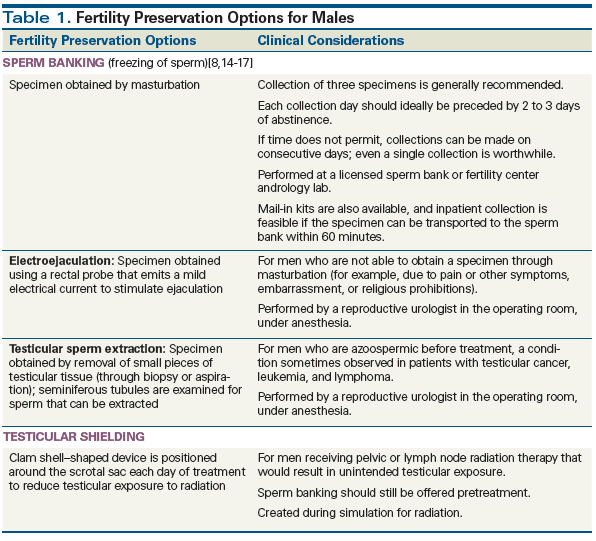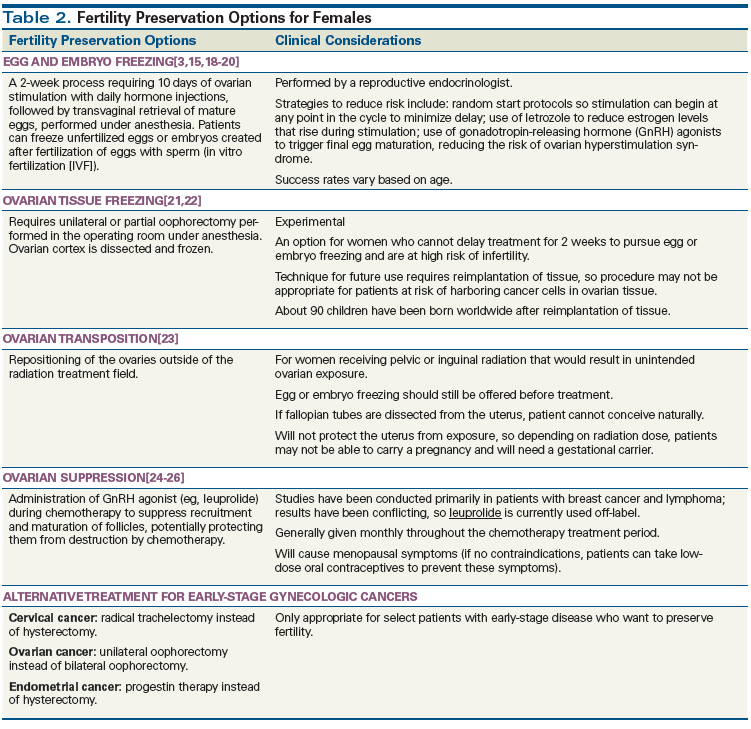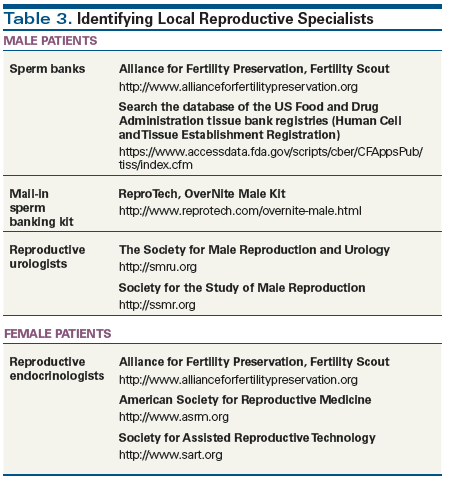More than 60,000 young adults are diagnosed with cancer each year in the United States. Many will not have started or completed their families at the time of diagnosis, and reproductive concerns are common. Practice guidelines from a number of professional organizations, including the American Society of Clinical Oncology, highlight the need for oncology clinicians to address fertility with their at-risk patients by discussing options for fertility preservation. Fertility preservation options for men include sperm banking (through manual stimulation, electroejaculation, and testicular sperm extraction) and testicular shielding. Fertility preservation options for women include egg and embryo freezing, ovarian tissue freezing, ovarian transposition, and ovarian suppression. This article highlights several practical strategies for integrating fertility preservation discussions into daily clinical practice and ensuring that oncology professionals are able to refer interested patients to appropriate reproductive specialists.
Introduction
Each year in the United States, more than 60,000 young adults, 20 to 39 years of age, are diagnosed with cancer.[1] The most common diagnoses requiring treatment that may impair fertility are lymphoma; leukemia; sarcoma; and cancers of the breast, testis, cervix, ovary, colon, rectum, brain, and spinal cord.[2]
Because many of these young patients will not have started or completed their families at the time of diagnosis, they often have reproductive concerns. Recognizing the significance of fertility as both a health and quality of life issue, a number of professional organizations have developed guidelines highlighting the need for clinicians working in all disciplines of oncology to address fertility with their at-risk patients-informing them of their risk of infertility, describing options for fertility preservation, and referring interested patients to appropriate reproductive specialists.[3-6] Not all patients will need, want, or be able to pursue fertility preservation before undergoing treatment for their cancer, but most want the opportunity to talk with health professionals about their options. This article will outline key information needed and practical ways that clinicians can integrate fertility preservation discussions and guidelines into their day-to-day practice.
Potential Reproductive Effects of Cancer Treatment
One of the most challenging aspects of discussing fertility with young newly diagnosed cancer patients is the impossibility of predicting with certainty a patient’s individual risk of infertility. Drug regimens are constantly evolving, and there are limited data (or no data) available on the fertility effects of most of the new targeted agents and immunotherapies. With the movement toward personalized medicine, the difficulty of predicting risk will only increase.
In general, alkylating agents pose the highest risk of infertility, and platinum analogs, anthracyclines, and taxanes pose an intermediate risk, with the degree of risk affected by the cumulative drug dose.[7-9] Specific treatment regimens are generally classified as being of high (> 80%), moderate (20% to 80%), or low (< 20%) risk of fertility impairment, but these are imprecise measures by which to base decisions about fertility preservation.
In men, chemotherapy and exposure of the testes to radiation can impair sperm production by destroying spermatogonial stem cells. Recovery of spermatogenesis after treatment depends on the survival of these cells and their ability to replicate and mature into sperm; sperm production generally returns within 1 to 3 years but can be delayed longer depending on the specific agents and doses used in cancer treatment.[7] Men may experience complete recovery, with normal sperm counts; partial recovery, with low sperm counts; or no recovery, with absence of sperm in the semen (azoospermia).
Pelvic irradiation or surgery may damage male reproductive system blood vessels, nerves, and collecting ducts, which can result in erectile and ejaculatory dysfunction. In many such cases, men may be producing sperm but cannot deliver it naturally to a female partner through intercourse.[8] Finally, cranial irradiation or surgery that damages the pituitary gland may cause hormonal alterations that impair spermatogenesis.
In women, oocytes can be destroyed by both chemotherapy and exposure of the ovaries to radiation.[9,10] Women are born with a finite number of oocytes, which are lost continuously through apoptosis. Maintenance of fertility and ovarian function depends on the number of oocytes remaining after treatment (the ovarian reserve); therefore, older women, who have fewer oocytes before undergoing treatment, are at greater risk of infertility than younger women. Some women go into menopause immediately; others may resume menses after treatment but remain at risk for developing infertility and menopause at a young age.
Radiation therapy to the pelvis with exposure of the uterus causes atrophy, fibrosis, and vascular changes, with subsequent damage to the endometrium and myometrium.[11] This may hinder embryo implantation and the establishment of pregnancy, and if pregnancy is established, uterine exposure to radiation confers a risk of miscarriage and preterm birth.
Cranial irradiation or surgery that damages the pituitary gland may result in hormonal alterations that impair oocyte maturation and ovulation.
Options to Preserve Fertility Before Treatment
Clinicians should initiate discussions about fertility preservation as early as possible in the treatment planning process. This will ensure that interested patients are identified and referred to appropriate reproductive specialists with enough time to pursue fertility preservation without delaying their cancer treatment. Tables 1 and 2 outline the options available for men and women to preserve fertility before treatment begins.
Integrating Fertility Preservation Discussions Into Clinical Practice
Understanding treatment-related risks to fertility and the options to preserve fertility before treatment begins is essential to being able to discuss these issues with patients. To effectively integrate these discussions into clinical practice, it will be helpful to identify and secure supporting educational resources and develop specific strategies to facilitate productive dialogues with patients.
Obtain printed educational materials about fertility preservation to provide to patients
Educational materials used should reinforce and expand on the information you will discuss with your patients. Create your own resources, or use brochures developed by other organizations. Suggested resources include the American Cancer Society (www.cancer.org), American Society of Clinical Oncology (www.cancer.net), Oncofertility Consortium (www.myoncofertility.org and www.savemyfertility.org), and Livestrong Foundation (www.livestrong.org/we-can-help/livestrong-fertility).
Identify local reproductive specialists to whom you can refer interested patients
Consider the ability of a reproductive specialist to provide the full range of services that your patients may need, as well as his or her experience in dealing with the medical and psychosocial issues faced by newly diagnosed cancer patients. Naturally, these will differ from the issues typically faced by couples with infertility who do not have cancer. Accessibility is equally important; consider the ability of the reproductive specialist to see patients within 24 to 48 hours, the relative ease of scheduling, and the specialist’s willingness to offer discounted rates and payment plans. Table 3 lists resources to help oncology professionals identify local reproductive specialists. Once specific providers are identified, it is useful to establish systems for ensuring timely referrals, communicating information, and coordinating care.
Identify resources to assist patients with the cost of fertility preservation
The associated costs of fertility preservation present a significant barrier for many patients. The average cost of sperm banking is $1,000 to $1,500,[12] and the average cost of freezing eggs or embryos is $11,900 to $12,400,[13] with an additional $3,000 to $8,000 for the medication required for stimulation of the ovaries. There are also annual fees for storage of gametes or reproductive tissue. Most insurance plans do not cover fertility preservation, and fees must be paid out-of-pocket. Many reproductive specialists offer discounted rates and payment plans for their services. Livestrong Fertility (through EMD Serono) and h.e.a.r.t. BEAT (through Ferring and Walgreens) offer free medication for eligible female patients undergoing egg or embryo freezing. ReproTech and California Cryobank offer discounted rates to patients with cancer for long-term storage of sperm, eggs, and embryos.
Avoid assumptions and biases regarding fertility preservation discussions
Consider how you currently address fertility discussions in your practice, and identify assumptions and biases that may unconsciously cause you to avoid these discussions with certain patients. Men and women with cancer want information about their risks and fertility preservation options regardless of their age, relationship status, parental status, stage of disease, prognosis, or socioeconomic status. Do not assume that patients with cancer will ask about fertility risks and fertility preservation options if they are interested. They may be too distressed and overwhelmed by their diagnosis, or it may not have occurred to them that the planned cancer treatment could pose a risk of infertility.
KEY POINTS
- Oncology clinicians should inform individual patients of their specific treatment-related risks of infertility and their options to preserve fertility before treatment begins, and interested patients should be referred to appropriate reproductive specialists.
- Fertility preservation options for men include sperm banking (through manual stimulation, electroejaculation, and testicular sperm extraction) and testicular shielding.
- Fertility preservation options for women include egg and embryo freezing, ovarian tissue freezing, ovarian transposition, and ovarian suppression.
- Strategies to assist clinicians in integrating the fertility preservation discussion into daily practice include having the appropriate patient education materials readily available, developing professional relationships with local reproductive specialists, and establishing a clearly defined process for making patient referrals.
Coordinate fertility preservation discussions with the healthcare team
Collaborate with the appropriate colleagues to decide when to initiate the fertility preservation discussion with an individual patient. Take steps to ensure that the appropriate conversations occur early enough in the planning of cancer treatment to allow the patient adequate time for decision making and to pursue fertility preservation if interested. Decide on the roles that each team member will play, maintaining consistency with your institution’s usual practice patterns as much as possible. For example, the physician could explain the risk of infertility in an initial conversation as he or she would do with other potential risks of the planned treatment. The nurse, nurse practitioner, or physician assistant could also introduce the option of fertility preservation during patient teaching sessions about chemotherapy, incorporating it into the discussion of side effect management. Patient navigators or social workers can also play a role in these discussions.
Develop an approach for beginning the fertility preservation conversation
Find language that is comfortable for you. For example, you may want to say to your patient: “Your treatment may affect your ability to have children in the future. If you wish, members of your healthcare team can explain what this means and we can discuss your options to preserve fertility before treatment begins. We can also refer you to a reproductive specialist if you are interested.”
Support patients during the fertility preservation discussion
Acknowledge the difficulty that patients face when learning of possible infertility, but be direct, honest, and matter-of-fact during fertility preservation discussions. Recognize that for many women, fertility preservation decisions are complicated because of the significant costs and the invasive nature of the procedures. Factors influencing a patient’s desire to proceed with fertility preservation include:
• The importance of having a biologic child.
• Concerns about the safety of ovarian stimulation and future pregnancy.
• The level of willingness to use assisted reproductive technology.
• The likelihood of success of the planned approach.
• Religious, cultural, and ethical beliefs.
• The degree of emotional distress from the cancer diagnosis.
• The patient’s perceived level of support from his or her partner and family.
It is important to discuss alternative ways to build a family if the patient faces future impaired fertility but is unable to pursue fertility preservation or chooses not to do so. These alternative strategies include the use of donor sperm, eggs, or embryos; surrogacy with a gestational carrier; and adoption.
Conclusion
Multiple options are available for young men and women who want to preserve their fertility before undergoing treatment with anticancer therapies that may impair their ability to have children. Oncology clinicians must ensure that patients are thoroughly informed of the risks to fertility posed by their cancer treatment regimen, as well as the fertility preservation options relevant to an individual patient’s situation. Patients interested in fertility preservation should be referred to appropriate reproductive specialists. Through proactive fertility discussions with patients and multidisciplinary involvement of the healthcare team before a patient begins cancer treatment, oncology clinicians can play a significant role in helping patients fulfill their hopes of becoming parents in the future.
Financial Disclosure:The author has no significant interest in or other relationship with the manufacturer of any product or provider of any service mentioned in this article.
References:
1. American Cancer Society. What are the key statistics for cancers in young adults? 2015. Updated June 10, 2015. https://www.cancer.org/cancer/cancer-in-young-adults/key-statistics.html. Accessed June 10, 2017.
2. American Cancer Society. Cancers that develop in young adults. 2015. Updated June 10, 2015. https://www.cancer.org/cancer/cancer-in-young-adults/cancers-in-young-adults.html. Accessed June 10, 2017.
3. American Society for Reproductive Medicine. Fertility preservation in patients undergoing gonadotoxic therapy or gonadectomy: a committee opinion. Fertil Steril. 2013;100:1214-23.
4. Coccia PF, Pappo AS, Altman J, et al. Adolescent and young adult oncology, version 2.2014. J Natl Compr Canc Netw. 2014;12:21-32.
5. Loren AW, Mangu PB, Beck LN, et al. Fertility preservation for patients with cancer: American Society of Clinical Oncology clinical practice guideline update. J Clin Oncol. 2013;31:2500-10.
6. Neuss MN, Gilmore TR, Belderson KM, et al. 2016 updated American Society of Clinical Oncology/Oncology Nursing Society chemotherapy administration safety standards, including standards for pediatric oncology. J Oncol Pract. 2016;12:1262-71.
7. Meistrich ML. Male gonadal toxicity. Pediatr Blood Cancer. 2009;53:261-6.
8. Trost L, Brannigan R. Fertility preservation in males. In: Gracia C, Woodruff TK, editors. Oncofertility medical practice: clinical issues and implementation. New York: Springer; 2012. pp. 27-50.
9. Ben-Aharon I, Shalgi R. What lies behind chemotherapy-induced ovarian toxicity? Reproduction. 2012;144:153-63.
10. Meirow D, Biederman H, Anderson RA, Wallace WH. Toxicity of chemotherapy and radiation on female reproduction. Clin Obstet Gynecol. 2010;53:727-39.
11. Teh WT, Stern C, Chander S, Hickey M. The impact of uterine radiation on subsequent fertility and pregnancy outcomes. Biomed Res Int. 2014;2014:482968.
12. LIVESTRONG Foundation. Family-building options for men. 2013. http://images.livestrong.org/pdfs/livestrong-fertility/LF_PreservationOptionsChart_Men.pdf. Accessed June 14, 2017.
13. LIVESTRONG Foundation. Family-building options for women. 2013. http://images.livestrong.org/pdfs/livestrong-fertility/LF_PreservationOptionsChart_Women.pdf. Accessed June 14, 2017.
14. Katz DJ, Kolon TF, Feldman DR, Mulhall JP. Fertility preservation strategies for male patients with cancer. Nat Rev Urol. 2013;10:463-72.
15. Kort JD, Eisenberg ML, Millheiser LS, Westphal LM. Fertility issues in cancer survivorship. CA Cancer J Clin. 2014;64:118-34.
16. Moss JL, Choi AW, Fitzgerald Keeter MK, Brannigan RE. Male adolescent fertility preservation. Fertil Steril. 2016;105:267-73.
17. Nangia AK, Krieg SA, Kim SS. Clinical guidelines for sperm cryopreservation in cancer patients. Fertil Steril. 2013;100:1203-9.
18. American Society for Reproductive Medicine. Mature oocyte cryopreservation: a guideline. Fertil Steril. 2013;99:37-43.
19. Cakmak H, Rosen MP. Ovarian stimulation in cancer patients. Fertil Steril. 2013;99:1476-84.
20. Rodriguez-Wallberg KA, Oktay K. Fertility preservation during cancer treatment: clinical guidelines. Cancer Manag Res. 2014;6:105-17.
21. Jensen AK, Macklon KT, Fedder J, et al. 86 successful births and 9 ongoing pregnancies worldwide in women transplanted with frozen-thawed ovarian tissue: focus on birth and perinatal outcome in 40 of these children. J Assist Reprod Genet. 2017;34:325-36.
22. Meirow D, Ra’anani H, Shapira M, et al. Transplantations of frozen-thawed ovarian tissue demonstrate high reproductive performance and the need to revise restrictive criteria. Fertil Steril. 2016;106:467-74.
23. Ghadjar P, Budach V, Kohler C. Modern radiation therapy and potential fertility preservation strategies in patients with cervical cancer undergoing chemoradiation. Radiat Oncol. 2015;10:50.
24. Blumenfeld Z, Zur H, Dann EJ. Gonadotropin-releasing hormone agonist cotreatment during chemotherapy may increase pregnancy rate in survivors. Oncologist. 2015;20:1283-9.
25. Del Mastro L, Ceppi M, Poggio F, et al. Gonadotropin-releasing hormone analogues for the prevention of chemotherapy-induced premature ovarian failure in cancer women: systematic review and meta-analysis of randomized trials. Cancer Treat Rev. 2014;40:675-83.
26. Lambertini M, Cinquini M, Moschetti I, et al. Temporary ovarian suppression during chemotherapy to preserve ovarian function and fertility in breast cancer patients: a GRADE approach for evidence evaluation and recommendations by the Italian Association of Medical Oncology. Eur J Cancer. 2017;71:25-33.



